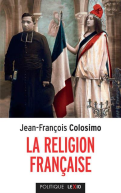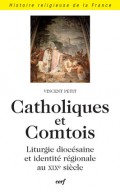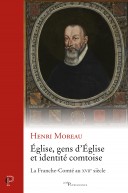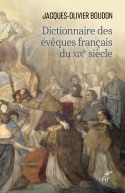
Le Passé présent
Collection Histoire religieuse de la France - N° 38
208 pages - sept. 2012
37,40€
À l'époque moderne, l'explication des cérémonies de la messe relève d'un genre littéraire connu depuis le haut Moyen Âge, en même temps qu'innovant. En effet, portés par l'élan pastoral post-tridentin, de nombreux auteurs s'y adonnent, tout en développant une critique parfois virulente des modèles hérités des « siècles obscurs » et, par voie de conséquence, en élaborant de nouvelles méthodes de description et d'exégèse des rites. Le projet de l'oratorien Pierre Lebrun (1661-1729) s'inscrit dans ce contexte, bien qu'il se distingue par son ampleur et son organisation. Le savant liturgiste orchestre une enquête sur la messe, combinant questionnaires adressés à un grand nombre de chapitres séculiers et d'ordres monastiques, copies de manuscrits anciens et recensions du maximum de sources susceptibles d'éclairer l'unité fondamentale du sacrement eucharistique derrière la diversité de ses inflexions locales. Pour couronner son entreprise, le père Lebrun publie entre 1716 et 1726 une « Explication littérale, historique et dogmatique des prières et des cérémonies de la messe » (4 volumes), très vite considérée comme un ouvrage classique de la science liturgique. Toutefois, l'accomplissement du dessein de Lebrun n'est pas aussi évident qu'il y paraît. En renouant les fils entre les documents collectés et la production imprimée qui s'en inspire, la présente étude propose une « enquête de l'enquête » établissant les contingences de la démarche de l'oratorien, de même que le rapport complexe qui, au fur et à mesure de l'avancement de ses travaux, s'établit entre son aspiration, les informations qu'il engrange et leur restitution publique. Mais, au-delà d'une expérience individuelle, cet ouvrage met au jour la contribution du père Lebrun à l'instauration, dans la culture chrétienne, d'un questionnement fondamental et toujours d'actualité : celui des modalités d'articulation du mystère de la messe et de ses formes pratiques dans l'histoire.
--
In today’s world, explanations of the ceremonies of the Mass recall a literary genre that dates from the Early Middle Ages, yet it is also innovative. Numerous authors, inspired by the post-Tridentine pastoral impetus, have applied themselves to the subject, sometimes being virulently critical of those models from the ‘Dark Ages’. As a consequence, they have elaborated new methods of description and ritual exegeses. The project of the Oratorian Pierre Lebrun (1661-1729) is just such an example, though its scale and organisation make it exceptional. The scholarly liturgist conducts a veritable investigation of the Mass, combining questionnaires addressed to a large number of secular chapters and monastic orders, copies of old manuscripts and an inventory of the maximum amount of sources that might illuminate the Eucharistic sacrament’s fundamental unity, underlying diverse local interpretations. As the crowning glory of his enterprise, Father Lebrun published, between 1716 and 1726, an Explication littérale, historique et dogmatique des prières et des cérémonies de la messe (4 volumes), which was very quickly regarded as a classic work of liturgical science. However, Lebrun’s achievement is not as obvious as it might appear. By renewing the links between the accumulated documents and the published work they inspired, the present study proposes an ‘enquiry into the enquiry’, establishing the contingency of the Oratorian’s approach, as well as the complex rapport which, as his work advanced, established itself between his aspiration, the information he gathered and its public presentation. But, over and above the singularity of the venture, this volume reveals Father Lebrun’s contribution to the Christian culture of a fundamental, and always pertinent, questioning: the method of articulating the mysteries of the Mass and its practical forms in history.
--
In today’s world, explanations of the ceremonies of the Mass recall a literary genre that dates from the Early Middle Ages, yet it is also innovative. Numerous authors, inspired by the post-Tridentine pastoral impetus, have applied themselves to the subject, sometimes being virulently critical of those models from the ‘Dark Ages’. As a consequence, they have elaborated new methods of description and ritual exegeses. The project of the Oratorian Pierre Lebrun (1661-1729) is just such an example, though its scale and organisation make it exceptional. The scholarly liturgist conducts a veritable investigation of the Mass, combining questionnaires addressed to a large number of secular chapters and monastic orders, copies of old manuscripts and an inventory of the maximum amount of sources that might illuminate the Eucharistic sacrament’s fundamental unity, underlying diverse local interpretations. As the crowning glory of his enterprise, Father Lebrun published, between 1716 and 1726, an Explication littérale, historique et dogmatique des prières et des cérémonies de la messe (4 volumes), which was very quickly regarded as a classic work of liturgical science. However, Lebrun’s achievement is not as obvious as it might appear. By renewing the links between the accumulated documents and the published work they inspired, the present study proposes an ‘enquiry into the enquiry’, establishing the contingency of the Oratorian’s approach, as well as the complex rapport which, as his work advanced, established itself between his aspiration, the information he gathered and its public presentation. But, over and above the singularity of the venture, this volume reveals Father Lebrun’s contribution to the Christian culture of a fundamental, and always pertinent, questioning: the method of articulating the mysteries of the Mass and its practical forms in history.
- Dimensions : 145x235x11
- ISBN : 9782204095617
- Poids : 340 grammes
DANS LA CATÉGORIE HISTOIRE RELIGIEUSE EN FRANCE
Eglise, gens d'Eglise et identité comtoise : la Franche-Comté au 17ème siècle
de Henri Moreau
1110 pages - oct. 2019






